- drach09's home page
- Posts
- 2022
- 2020
- June (1)
- 2019
- 2018
- 2017
- 2016
- 2015
- 2014
- December (13)
- November (2)
- October (5)
- September (2)
- August (8)
- July (9)
- June (7)
- May (5)
- April (4)
- March (4)
- February (1)
- January (2)
- 2013
- December (2)
- November (8)
- October (5)
- September (12)
- August (5)
- July (2)
- June (3)
- May (4)
- April (8)
- March (10)
- February (9)
- January (11)
- 2012
- 2011
- October (1)
- My blog
- Post new blog entry
- All blogs
Run-11 Transverse Jets: First Look at JP2 Embedding
During the jet meeting, two weeks ago, it was suggested that I use the Run-9 di-jet embedding for my high-pT JP2 and AJP triggers from Run-11. For partonic pT-bins 25 to -1, i.e. infinity, there is no di-jet filter. Given that the inside of STAR was very similar in Run-9 as in Run-11 the expectation is that the existing sample will work just fine for my purposes. Then, I will need to make a request to fill in the lower-end of JP2 and AJP and all of VPDMB, JP0, and JP1.
Thanks to big help from Grant, I show here a first look utilizing the existing Run-9 embedding (pT-bins 25 to -1) for mid-rapidity di-jets at 500 GeV. I match to parton jets and compare embedding to JP2*L2JetHigh triggers from Run-11 500 GeV transverse.
Vertex Studies
The expectation is that the vertex for Run-11 will be narrower than Run-9. Thus, the existing vertex weighting used for the di-jet analysis is not expected to be appropriate for Run-11. As one can see in Figs. 1-4 this ends up to be the case.
Figure 1
No Weighting (left) and partonic weighting only (right).


Figure 2
Partonic weighting only (left) and partonic and vertex weighting (right).

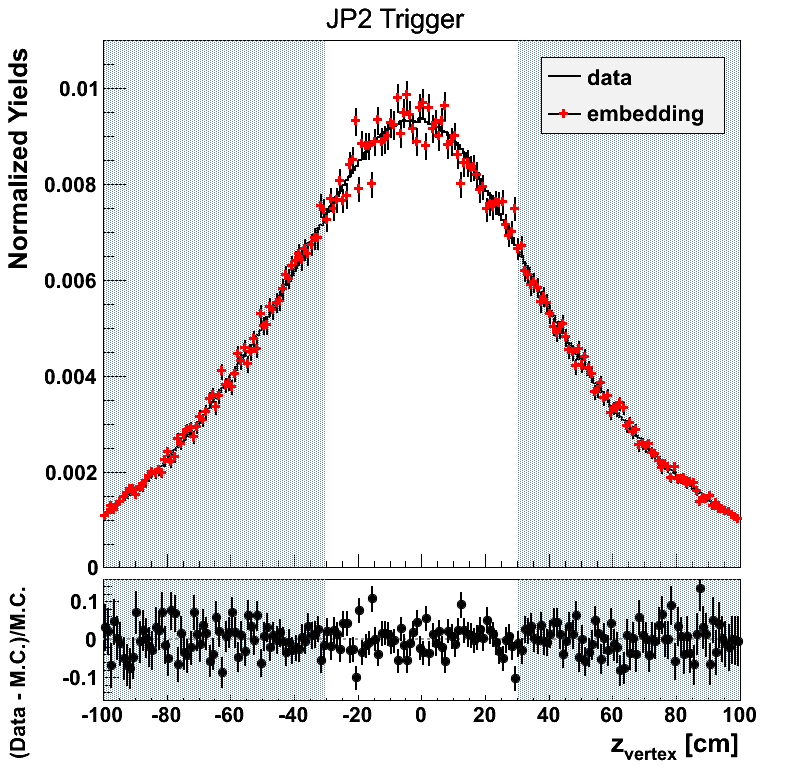
One can see that comparing the matched distribution to the data distribution, indeed, the Run-11 vertex distribution is narrower than in Run-9. The weighting function (as seen in Fig. 4) sucessfully generates a matched vertex distribution consistent with the Run-11 data distribution.
Figure 3: Vertex Difference
No Weighting (left) and partonic weighting only (right).


I model the vertex weight with a Gaussian + 4th-order polynomial. I, then, fit the vertex difference and drop parameters consistent with zero. I find that all parameters are relevant when I set the Gaussian mean to zero and drop p4. The fit χ2 probability is 51.2%.
Figure 4
Partonic weighting only (left) and partonic and vertex weighting (right).

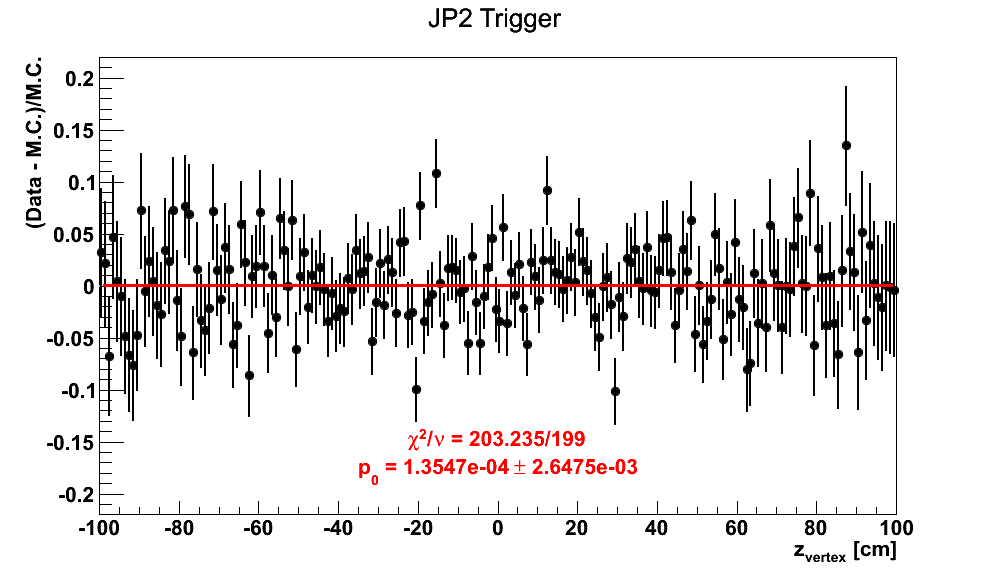
Applying the vertex weighting (1+Func) successfully matches the matched Run-9 distribution to the Run-11 data distribution. The χ2 probability is 40.4%.
Transverse Momentum Studies
For Run-11 define JP2 jets by requiring VPDMB, JP0, and JP1 not fire, requiring the jet to have pT > 16.3 GeV/c, and matching the jet to a valid JP2*L2JetHigh or AJP patch. Since I only look at partonic pT bins above 25 GeV/c, the matched trigger should not turn on until some point around 25 GeV/c. Given where the JP2 threshold was set, the turn-on will be lower. So, the pT comparison should not match up well until we obtain the fill-in from new embedding below partonic pT of 25 GeV/c.
Figure 5
No Weighting (left) and partonic weighting only (right).

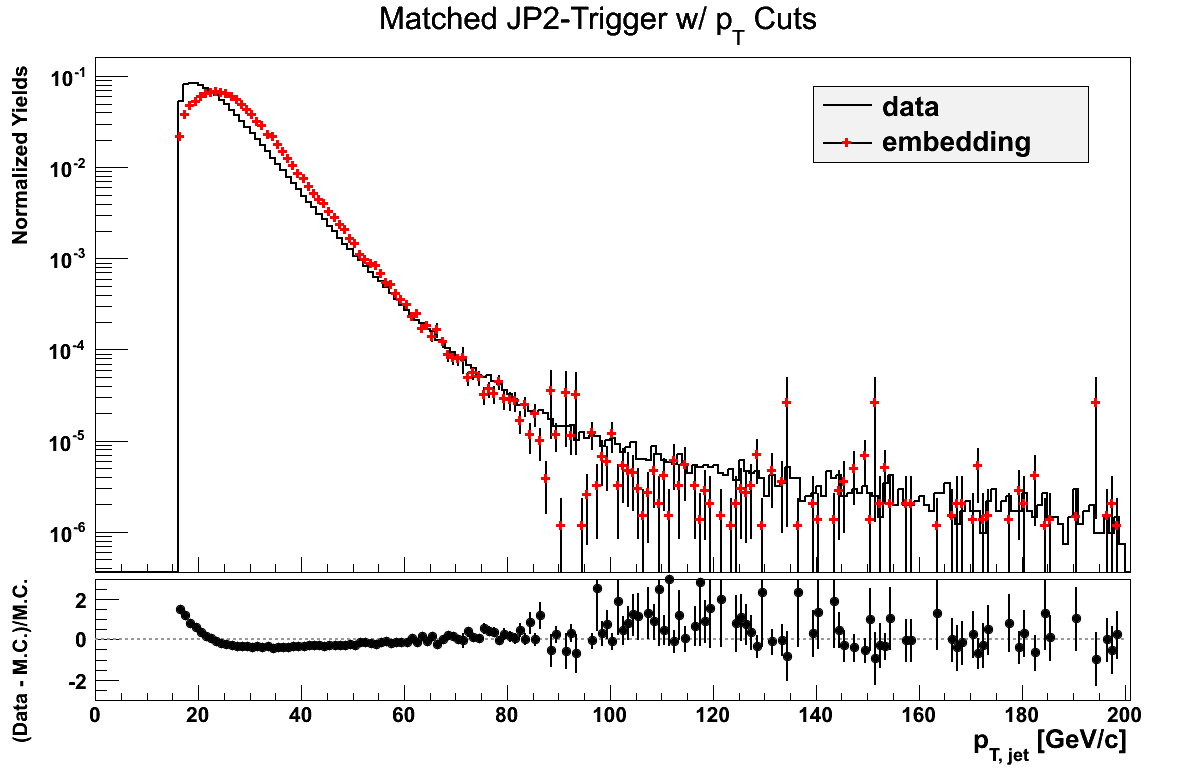
Figure 6
Partonic weighting only (left) and partonic and vertex weighting (right).

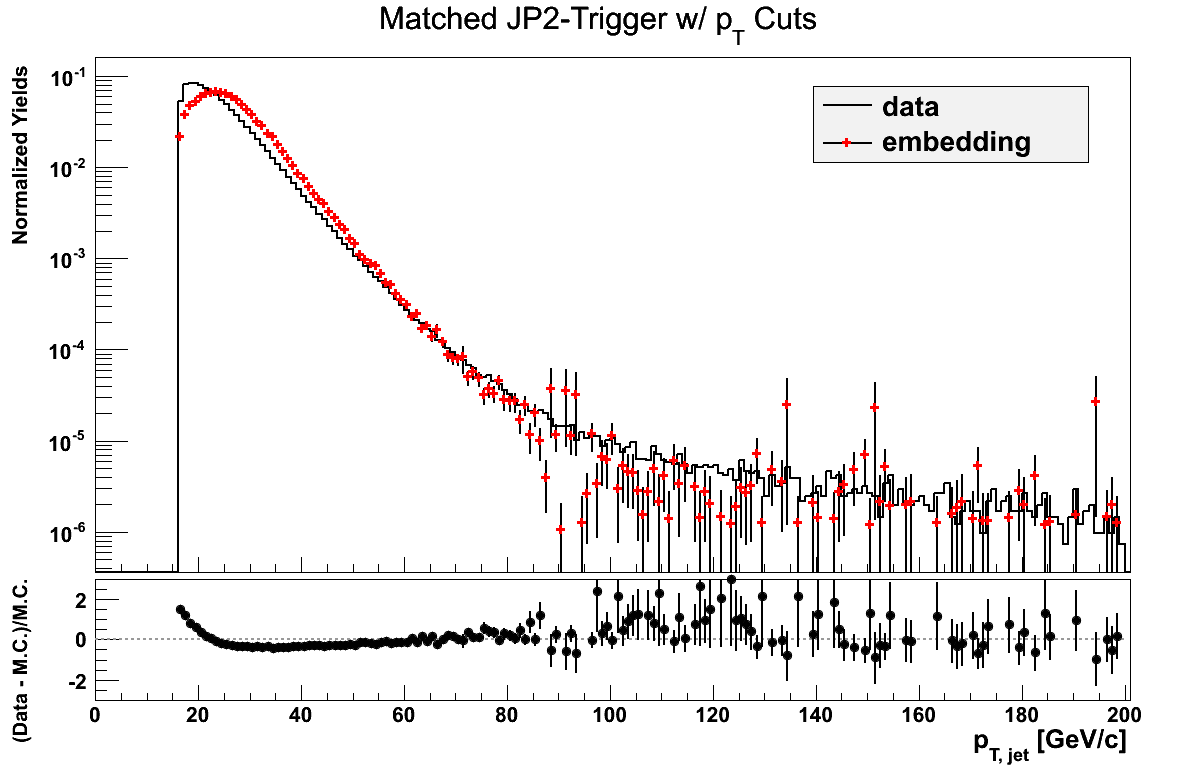
After comparing the weighted embedding to data, the match-up is not very good, but it seems sensible given the available embedding events.
Pseudorapidity and Azimuth Studies
Ultimately, one of the main studies for the embedding is to look at the resolution of the Sivers and Collins angles. Thus, it is interesting to see how azimuth and pseudorapidity compare between the Run-9 and Run-11 data. I do not expect the distributions to match exactly, as the detectors undoubtedly had some differences between Run-9 and Run-11 (e.g. different hot towers in the BEMC). I don't expect the resolution to be dramatically affected by these differences, but it is still interesting to see if the distrubutions are similar.
Figure 7
For this and following figures, I only look at fully-weighted embedding.
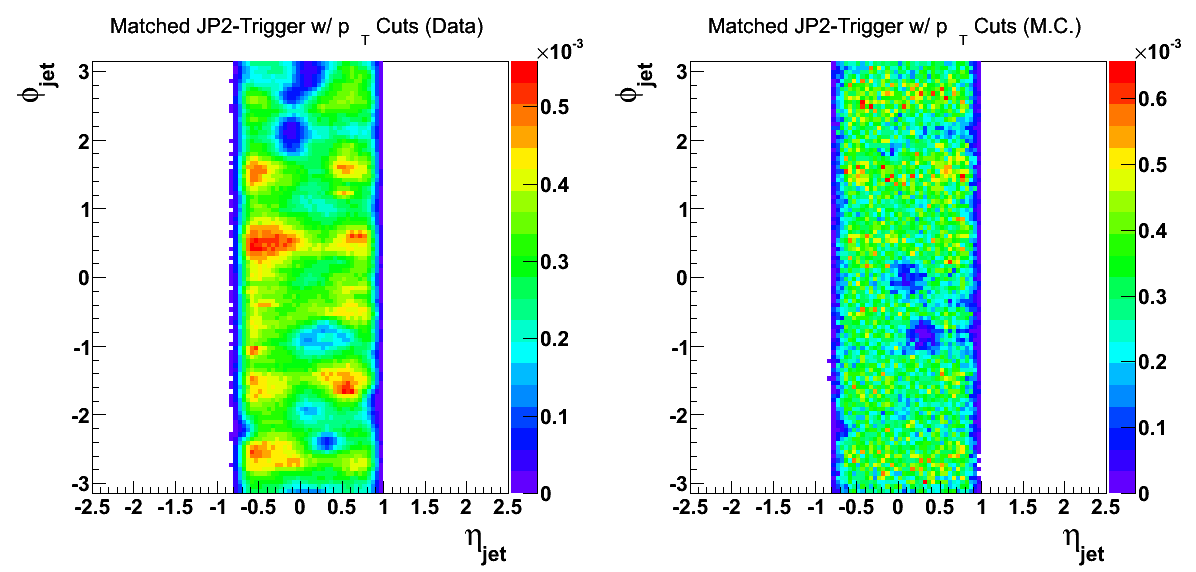
The embedding does show a more uniform detector response than the Run-11 data. In some cases, similar cold regions match, e.g. (η,φ) = (0.3,-1).
Figure 8
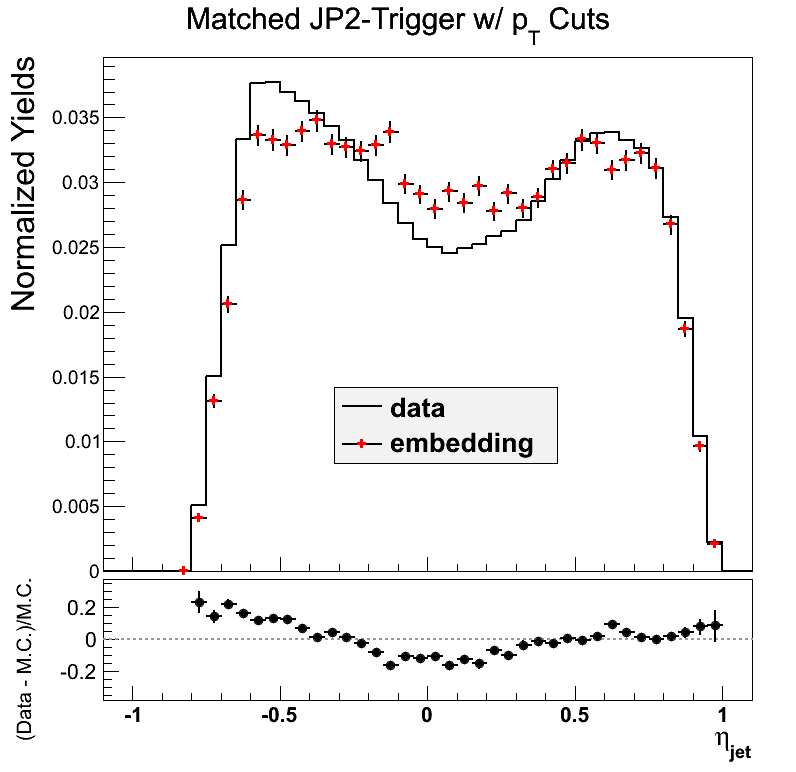
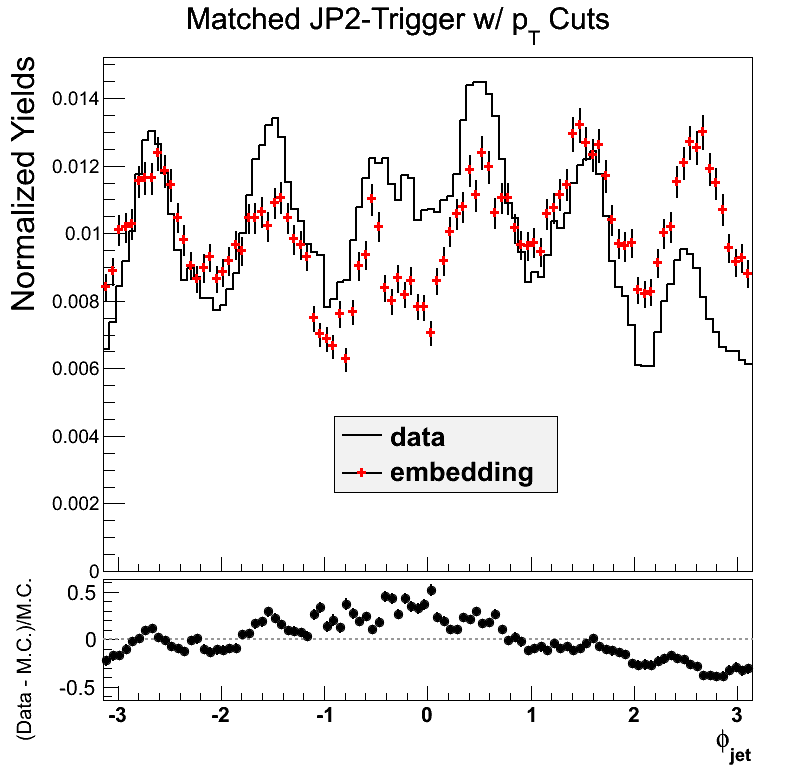
Differences in η integrated over φ are quite reasonable (< 20%) and a bit higher in φ integrated over η (< 50%).
Partonic Weighting
float NumEvts[12], Xsec[12];
NumEvts[0] = 13790; // 4-5
NumEvts[1] = 59476740; // 5-7
NumEvts[2] = 16398079; // 7 - 9
NumEvts[3] = 5376795; // 9-11 Number from Pythia
NumEvts[4] = 423980; // 11-15
NumEvts[5] = 376878; // 15-25
// NumEvts[6] = 373661; // 25-35
NumEvts[6] = 245374; // 25-35
NumEvts[7] = 373026; // 35-45
NumEvts[8] = 93913; // 45-55
NumEvts[9] = 23558; // 55-65
NumEvts[10] = 5744; // 65-75
NumEvts[11] = 2915; // 75--1
// Double_t MinbXsec = 31.42;
Xsec[0] = 1.48200000000; // 4
Xsec[1] = 0.74900000000; // 5
Xsec[2] = 0.15510000000; // 7
Xsec[3] = 0.04500000000; // 9
Xsec[4] = 0.02211000000; // 11
Xsec[5] = 0.00571000000; // 15
Xsec[6] = 0.00034250000; // 25
Xsec[7] = 0.00004323000; // 35
Xsec[8] = 0.00000792400; // 45
Xsec[9] = 0.00000180900; // 55
Xsec[10] = 0.00000047350; // 65
Xsec[11] = 0.00000019520; // 75
float lumi = NumEvts[pTbin]/Xsec[pTbin];
return 1./lumi;
- drach09's blog
- Login or register to post comments
